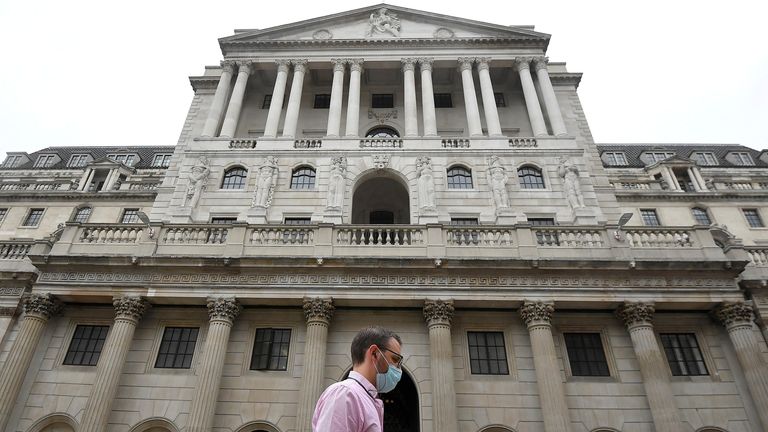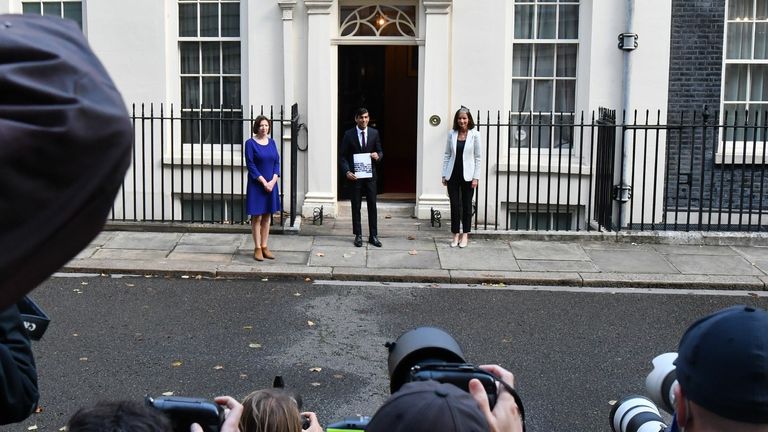It is the dog that has not barked so far during this pandemic.
Scores of businesses have gone bust and hundreds of thousands of people have lost their jobs.
However, to date, there has not been a rise in the number of people defaulting on their mortgage during the COVID-19 crisis.
The latest Credit Conditions Survey from the Bank of England, a quarterly survey of banks and building societies, reveals that the default rate on secured loans to households was unchanged during the three months to the end of September.
That is the good news. The bad news is that, according to those surveyed, the default rate is expected to go up during the final three months of the year.
And that, in turn, means that households and businesses are likely to find it harder to obtain credit in coming months.
The survey found that, while the availability of secured credit such as mortgages is expected to remain unchanged over the three months to the end of November, lenders have been tightening their credit scoring criteria for mortgage borrowers during the most recent quarter and are expected to continue doing so during the current quarter.
Similarly, the availability of unsecured credit – such as personal loans – to households is expected to fall during the current quarter, with lenders likely to tighten their lending criteria. The availability of credit to businesses, both large and small, is also expected to fall during the final three months of the year.
This is likely to lead to disappointment for some would-be borrowers.
The survey found that lenders expect demand for mortgages to remain unchanged and for demand among those households seeking to remortgage to rise.
Demand for credit cards and other forms of unsecured lending is also expected to rise during the current quarter, as is demand for credit from medium-sized businesses, although not from small or large firms.
The survey, carried out during the first 18 days of September, also confirms a growing trend that has already been picked up – that would-be mortgage borrowers with deposits of less than 10% of the purchase price are struggling to obtain credit.
It suggests that a lot of would-be borrowers, especially first-time buyers, will be unable to take advantage of the Chancellor Rishi Sunak’s temporary cut in some – but not all – levels of stamp duty on house purchases.
As Andrew Montlake, managing director at the mortgage broker Coreco, put it: “The expectation of higher default rates and stricter credit scoring criteria in the fourth quarter is a sign of the direction the wind is blowing.
“In some cases lenders are already raising rates to stave off demand.
“It’s understandable that demand for secured loans for house purchase increased in the third quarter as the economy was on ice for much of the second.
“We’re now starting to see demand for mortgages drop off at higher loan-to-values, as first time buyers with small deposits are increasingly aware that the chance of getting a mortgage agreed are somewhere between slim and zero.”
The trend is borne out by the latest UK Mortgage Trends Treasury Report from the data provider Moneyfacts.
It finds that there are 153 fewer mortgage products available since the beginning of September while the total number of products available is at its lowest since May 2010. Meanwhile, the average rate on a two year fixed rate mortgage has risen by 0.14% during the last month and the five year fixed rate by 0.13%.
At the same time, the number of mortgages available on a 95% loan-to-value basis has shrivelled away to almost nothing, with many mortgage lenders now unprepared to lend more than 85% of the value of a property.
That the banks are becoming more cautious, though, can hardly be a surprise.
UK lenders reported some £18bn worth of extra loan losses during the first six months of the year alone and, while it recently revised its forecast lower, the Bank is still expecting loan losses related to COVID-19 to come in at “somewhat less than £80bn”.
That, though, was based on the forecasts in the Bank’s most recent Monetary Policy Report, published on 6 August, which were for a 9.5% contraction in UK GDP for the whole of 2020.
And that forecast is beginning to look optimistic.
The Organisation for Economic Cooperation and Development has predicted a contraction in GDP of 10.1% this year and growth of 7.6% next year – making the UK among those likely to be hardest hit among leading economies.
So it would be no surprise to see forecasts of expected loan losses starting to rise again.
Put all of these things together and it is hard to escape the conclusion that the mini housing boom unleashed by Mr Sunak is petering out.
Google searches for property portals like Rightmove, On The Market and Zoopla, which are normally a good indicator of housing market activity, have started to drift lower.
Meanwhile, the latest residential market survey from the Royal Institution of Chartered Surveyors suggests that, although the upturn in sales is expected to continue over the coming three months, there is a growing expectation that sales will fall during the next year, particularly once the furlough scheme finishes.
This may be as good as it gets, for now, for the housing market. Should activity start to slow, expect mounting calls on Mr Sunak to extend the temporary reductions in stamp duty ahead of their scheduled expiry at the end of March next year.



